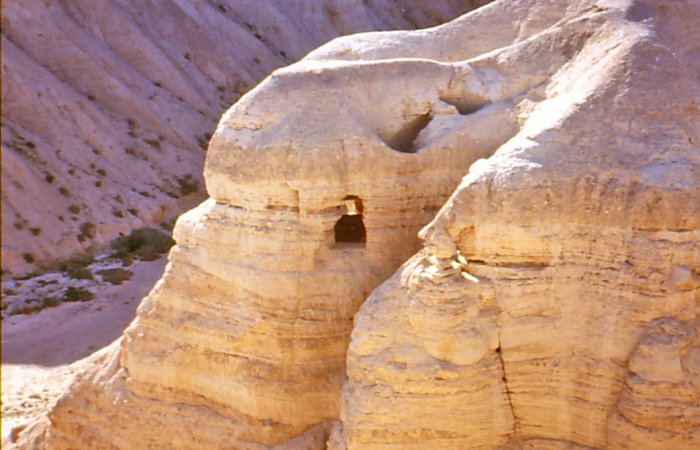Jan Bartek – AncientPages.com – One of the most interesting archaeological sites is Qumran in West Jordan. This is where scientists in 1947 unearthed clay pots filled with ancient scrolls hidden in eleven caves.
Today known as the ᴅᴇᴀᴅ Sea Scrolls, these ancient texts were written using a carbon-based ink and are mostly in Hebrew, with some in Aramaic (a Semitic language, allegedly spoken by Jesus) and in Greek.

Caves at Qumran in the West Bank, Middle East. In this area the ᴅᴇᴀᴅ Sea Scrolls were found. Credit: Grauesel – CC BY-SA 3.0
Preliminary analysis showed the texts belonged to the Essenes, members of a religious sect, or brotherhood that flourished in Palestine from about the 2nd century BC to the end of the 1st century AD.
The ᴅᴇᴀᴅ Sea Scrolls have been studied for years but many questions still remain unanswered and there are also many controversies.
One of these issues is for example, who wrote the ᴅᴇᴀᴅ Sea Scrolls and then hid them away in the caves around Qumran. Some scholars believe that the Essenes were not responsible for the ᴅᴇᴀᴅ Sea Scrolls at all, but the manuscripts were written by priests of Jerusalem’s Second Hebrew Temple and later transported to Qumran and safely hidden from the Romans.
It should be added this particular theory has many opponents.
The ᴅᴇᴀᴅ Sea Scrolls contain a large variety of writings: fragments of every book of the Old Testament (except the Book of Esther), rules for religious rituals, texts on the preparation of the Qumran sect for war at the End of Time, calendars, horoscopes and much more.
A recent study now reveals the ᴅᴇᴀᴅ Sea Scrolls and a medieval document from the Cairo Genizah mention an ancient religious ceremony that may shed light on the mysterious Qumran site.
According to Dr. Daniel Vainstub of Ben-Gurion University of the Negev there are a couple of puzzles related to the Qumran site. It is still unknown where the Qumran site was once a fortress or not.
It is strange scientists have discovered remains of ancient public buildings, but no private dwellings at the site. It is also unclear why thousands of pottery vessels placed where only a few dozen residents lived. Archaeologists also wonder why the area features such a multiplicity of mikvaot ritual baths, including very large ones, for such a small population.
Dr. Vainstub now suggests the Qumran site was indeed a place where the Essenes gathered, but it was not their permanent residence. Instead, the site was used to hold their annual celebration of the “pᴀssing of the covenant.”
“I looked both at the texts and the archaeological remains, and what I have seen perfectly fits this possibility,” Vainstub said.
As the Jerusalem Post reports, “the ceremony was modeled after one described in Deuteronomy, chapters 27-28. In the pᴀssage, Moses instructs the Israelites on how to proclaim God’s blessings and curses on Mount Ebal and Mount Gerizim after they enter the land, which is subsequently described in the Book of Joshua.
The rules of the Essenes’ version are described in the so-called “Community Rule” manuscripts, as well as in the Damascus Document copied around the year 1,000 CE and retrieved in the Genizah.”
However, Vainstub wrote in the paper, “the description of the ceremony in the Damascus Document includes a sentence containing two pieces of information that are of critical importance for our purposes and are missing in the Community Rule: ‘And all [the inhabitants] of the camps shall ᴀssemble in the third month and curse anyone who deviates either to the right [or to the left from the] Torah.’”,
Thi sentence has led Vainstub to consider that gathering at Qumran took place in a specific time – the month of Sivan, when the festival of Shavuot falls – and that people from different places (camps) were called to convene in one site.
Therefore, according to Vainstub, the rules that were previously thought to apply to Essenes’ general lifestyle describe the specific ceremony instead.
“It could be that Qumran was even built for the purpose of this gathering,” he wrote.
Those who convened ahead of Shavuot did not need to be housed in buildings, but rather slept outside or in one of the numerous caves of the areas, where millennia later the manuscripts that came to be known as the ᴅᴇᴀᴅ Sea Scrolls would be found.
See also: More Archaeology News
“My theory is also consistent with the fact that the scrolls did not necessarily originate from Qumran, but rather were brought to the caves from all over the country and were left in the caves over the decades,” Vainstub wrote.
“Some dozens of permanent residents of Qumran, perhaps with the help of small Essene groups living nearby close to the springs on the shores of the ᴅᴇᴀᴅ Sea, had to host many hundreds of people at the site once a year in ever-increasing numbers,” Vainstub concluded in the paper. “The site of Qumran, with its facilities, caves and surfaces, accords with the evidence for the annual gathering that emerges from the scrolls. No other known site is suitable for such a purpose.”
Written by Jan Bartek – AncientPages.com Staff Writer





